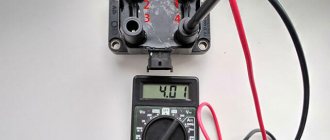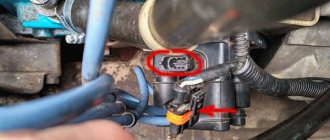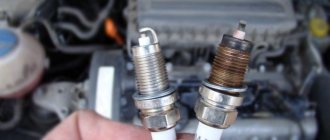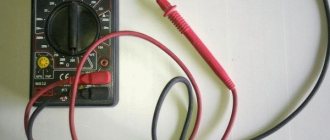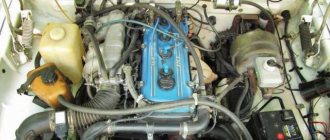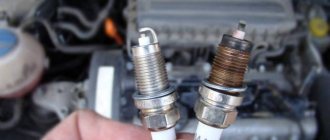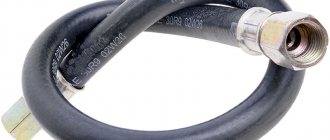One of the most common reasons causing the inability to start a gasoline engine is the banal lack of spark at the spark plugs. Under such circumstances, there is nothing to ignite the combustible mixture on the compression stroke, and as a result, the engine refuses to work. Depending on what kind of power system the car is equipped with, it is determined exactly how to proceed to determine the exact cause of the lack of a spark and measures to return it. We’ll talk in more detail about this problem on injection engines today. Interesting? Then be sure to read the material below to the end.
Checking for spark
Let's say your fuel-injected car has stopped responding to the ignition key and refuses to start. It is quite irrational to immediately complain about a malfunction in the ignition system. First of all, you need to make sure that it is the spark that has disappeared and not something else that has broken. To check spark plugs for the presence of the coveted “light”, you can resort to several procedures at once. Perhaps the most effective and simple ones are the following:
- The first method is a mass test. To implement it, you need to turn off the ignition, unscrew each spark plug in turn and, placing its body against ground (the metal body of the engine), try to start the engine;
- The second method is checking with a multimeter or a tester based on a piezoelectric element. This diagnostic option is quite similar to the method described above, except that the spark plug is applied not to ground, but to the contacts of the tester or multimeter. However, in this case there is no need to “turn” the starter; the spark must come from the devices themselves.
If, as a result of the above-mentioned testing methods, sparking on the spark plug is not detected, or there is a spark, but weak (dimmed, dim, dull), it is necessary to identify the cause of the malfunction. Do not forget that operating a car with a poorly functioning ignition negatively affects engine performance and significantly reduces its service life.
Note! Checking the spark on the injector is an extremely important undertaking, since such cars have very sensitive electronics. Considering this particular feature, it is important to carry out diagnostics carefully and as quickly as possible, that is, without numerous repetitions of the test and using only high-quality testers.
No spark VAZ 2109
What to do if the spark is lost on the VAZ 2109? Naturally, the engine will not start without a spark, so every car owner should know the solution to this issue. So, the main reasons that there is no spark are the following: 1) The switch has failed 2) The Hall sensor has failed 3) The timing belt has broken 4) The ignition coil has failed 5) The ignition switch contact group 6) The ignition distributor cover contacts 7) Fault in the wiring (any of the wires of the electrical circuit ignition switch-switch-ignition coil-Hall sensor is torn off or rotted). Above are the most basic faults due to which there is no spark on the ninth Zhiguli model. Let's look at each of them in order. Let's immediately make a reservation that the car must have a charged battery that rotates the engine crankshaft. If your starter does not turn the crankshaft of the VAZ 2109 engine, then first get it to turn it, and then look for a spark. 1) To check that the switch is working, it must be replaced with a known good one.
Switch
Experienced VAZ owners know that the switch is not the most reliable part, so it is always necessary to have a spare switch in the glove compartment. We remove the switch under suspicion and install a known good one. We try to start it - if it starts, then the problem is in the switch. If it doesn’t start, we put the old switch back and look further. 2) To check the Hall sensor, it is also better to replace it with a known good one, although there is a method for checking the Hall sensor directly on the car.
Hall Sensor
We replaced the Hall sensor and tried to start it again. If a spark appears, then the problem was in the Hall sensor. If a spark does not appear on the VAZ 2109, move on. 3) To make sure that your timing belt is not broken, remove the cover from the ignition distributor and turn the crankshaft with the starter.
Ignition distributor slider
The ignition distributor slider should turn. If it doesn't turn, change the timing belt. 4) The ignition coil fails quite rarely, so it is better to check it as indicated here. If the check indicates a malfunction of the ignition coil, change it and look: a spark appears, which means the problem is in the coil, if it does not appear, move on. 5) The ignition switch contact group may also be the reason why there is no spark. I had this thing: after two days in the cold, for some reason the spark on the VAZ 2109 disappeared. The starter turns briskly, but there is no spark. I noticed that when you turn on the ignition, there is power to the ignition system at pin B of the ignition coil. When you turn the starter, the power from contact B of the ignition coil disappears. The thing is incomprehensible and difficult to diagnose; you need to measure the voltage between ground and contact B of the ignition coil with a multimeter or a light bulb. To crank the starter, you need to turn the ignition key and somewhere in the contact group of the ignition switch there is no contact, so when the starter rotates, power is removed from the ignition system. It can be treated by replacing the contact group of the ignition switch, or as follows: Using a locking button, we connect +12V from the battery to contact B of the ignition coil.
We supply +12V to the coil bypassing the ignition switch
We pressed the button, +12V went to the coil and the ignition system will be powered even when the starter rotates.
Using a locking button, we power the ignition system
A spark will appear, start it, press the button again to break the direct circuit from the battery to the coil. If the button is left pressed, the car will not stall when the ignition is turned off. This method is quite acceptable, as in my case: the car is parked in -20 degrees cold, and it needs to be started. Changing the ignition contact group in this case is not the fastest and most convenient solution. You won’t do anything bad with a button from the battery to the coil. When you have time, you can safely make repairs somewhere in the garage, and put the jumper with the button in the trunk and save it just in case. 6) In general, when there are no sparks, this must be checked first. If there is no spark at the spark plug, then you need to check whether there is a spark from the ignition coil.
Remove the central wire and bring it to ground
We remove the central wire from the ignition coil, bring it a centimeter closer to ground and turn the starter. If there is a spark, then remove the cover from the ignition distributor. We check the integrity of the slider resistor and clean the contact of the ignition distributor cap.
Cleaning the contacts of the ignition distributor cover
7) The last problem due to which there is no spark on the nine is a malfunction in the wiring of the ignition system. As a rule, very often they are visible to the naked eye: wires are torn off or melted, connectors of the switch and Hall sensor are poorly connected. But if visually everything is in order, then the malfunction can be determined only after testing all the wires of the ignition system with a multimeter. Naturally, not everyone knows how to use a multimeter, so if the reasons described above did not help you find a spark on the VAZ 2109, then we ask for help from an auto electrician.
Causes of sparking problems
If there is no spark on the injector, and not, for example, on a carburetor or gear motor, you will have to try to identify the reasons for its loss. This is due to the fact that there are slightly more factors influencing spark formation in injection systems and they look more multifaceted. If we summarize the general list of possible causes of the problem, then it is worth highlighting the following most common ones:
- The spark plug or spark plugs are flooded with fuel - there is either no spark or very weak, the spark plugs themselves are wet;
- The spark plug or spark plugs are faulty - there is no spark at all, deposits on the contacts are usually black or white;
- The crankshaft sensor, ignition module, ignition coil, switch or distributor is faulty - there is no spark at all, the engine shows no signs of “life”, the injector does not work correctly;
- High-voltage wires have broken through or there has been a loss of contacts - one or two spark plugs do not work, the rest are fully operational;
- The injector electronics (ECU or wires) are faulty - the unit does not work correctly, there is no spark at all spark plugs;
- The injector nozzles are clogged - there is no spark at the spark plugs of specific cylinders, the injector is not working correctly.
Please note that for a complete and most accurate diagnosis, it is necessary to carry out several procedures at once:
- Naturally, check for a spark;
- Assess for the presence of the symptoms described above;
- Check for relevant errors on the dashboard or on-board computer screen;
- Check the potentially faulty unit (disassembly, cleaning, diagnostics with a multimeter, etc.).
If, based on the results of all diagnostic procedures, the problem is not identified, then, most likely, a visit to the service station cannot be avoided. Otherwise, it is quite acceptable to carry out repairs yourself, of course, if you have the proper skills, abilities and tools.
What are the reasons for the lack of ignition?
The reason is simple. It consists of a breakdown of any part of the system.
So, for example, a breakdown can occur in:
- Switch. As a result of such a breakdown, the required voltage ceases to flow to the coil.
- Sensor. A broken sensor will not be able to transmit current to the switch.
- Belt. If the belt breaks, the operation of the entire system is disrupted.
- Reel. A breakdown in the coil stops the process.
- Candlelight. Carbon deposits or moisture prevent a spark from forming.
- The distributor cover and its contacts. Such a malfunction does not allow voltage to be transferred to the spark plug.
Also, a malfunction can be detected in the ignition switch itself. Then the process stops before it even begins. Another reason may be a wiring fault, resulting in communication between elements being interrupted.
Bringing the car back to life
As for why a spark disappears, everything is probably very clear. Now, it would not be amiss to consider the order of her return. The reality is that in most cases, getting the spark back is a simple matter and just involves carefully checking the broken car. To be more precise, to normalize sparking it is required:
- Firstly, check the spark on the injector using the method described above, make sure that it has disappeared, and, at least indirectly, try to determine the cause of the malfunction;
- Next, it is enough to assess the current circumstances and act based on them. As typical situations, we suggest considering solutions to the following problems:
- the spark plug is wet, the presence and strength of the spark are unimportant, the carbon deposits are correct (brick color) - wipe the part and screw it back in;
- the spark plug is wet (not always) and the carbon deposits are incorrect (white or black) - clean, dry the part and try to start the engine, if there is no result, change the spark plug and deal with problems in the fuel system (cleaning the injector, checking the ECU, etc.);
- the spark plug is wet, there is no spark at all, the color of the soot is not important - we try to change the part, if there is no result, we check the ignition system and the operation of the injector.
In principle, in theory there are no particular difficulties in repairs of this kind. Despite this, it often causes difficulties in implementation for inexperienced motorists. To solve these, you need to act in the order described above, but if something doesn’t work out, it’s better to turn to professionals at a service station. This approach to repairs will not only save time, but also guarantee trouble-free operation of the car in the future.
Perhaps this concludes the most important information on today’s issue. We hope that the material presented was useful to you and provided answers to your questions. Good luck in operating and maintaining your car!
Possible reasons for absence
Most modern cars are equipped with an abundance of sensors. They make the car owner’s life easier and make repairs more difficult. In the electronics responsible for the operation of an injection engine, there are, of course, several sensors responsible for the spark formation process. However, the prerequisites for the absence of a spark (VAZ-2110, injector, 8 valves) usually occur in other components. There are a number of types of possible breakdowns. The first includes various problems in the car’s fuel system. This includes malfunctions when fuel is not allowed to enter the cylinders or the supply is malfunctioning.
If there is no spark (VAZ-2110, injector, 8 valves), then you will like it due to the fuel system. Often the pump relay or the submersible element itself burns out. The test is done by ear.
Next come the tasks related to the electronic part. These are some of the most common defects. With such breakdowns, an electronic discharge does not reach the spark plug. The mixture will not be set on fire. In the midst of global problems - a complete failure of the engine, a broken timing belt. These defects should not be dwelled upon carefully.
The easiest way to check the ignition of a VAZ-21099
This technique does not require the use of special tools and devices. In this case, the entire ignition circuit is checked, with the exception of the Hall sensor. To work, you only need a nail or paper clip and a small piece of wire with stripped ends.
First, we pull out the high-voltage wire from the distributor cover. During the verification process, it must be kept at a distance of about 10 mm from the mass. Turn on the ignition. We remove the Hall sensor connector and insert one end of the wire into its middle contact, to which the green cable fits. With the other end of the wire we touch ground several times. There should be a spark during separation. If there is a spark, it means that either the Hall sensor has failed or there is no contact. Quite often, the wires inside the distributor are chafed by the plate, and it happens that the connector simply becomes loose. However, there may be such an option. When checking there is a spark, but when connected to the distributor cover, there is no spark on the spark plug caps. In this case, the slider should be replaced. When the VAZ-21099 carburetor does not spark when checking, the switch may have failed or the ignition interlock circuit, if provided, is broken.
Often the reason for the lack of a spark may be wear on the contacts in the ignition switch. In this case, the starter will rotate, but no power is supplied to the ignition system. This problem can be resolved by replacing the ignition switch.
Stage one
Usually the symptoms of difficulty are the following: the starter rotates regularly in its own standard mode, but the engine does not want to start. One of the most possible circumstances is a fuel pump that does not start. When on injection “tens” it is submersible and is located directly in the tank.
There is an option to check the element by the presence of operating sound. Turn on the ignition - there should be a rumble in the area of the rear seats. He is absent from time to time. In our version, you should check the fuses. The VAZ-2110 is a fuel-injected car, and the fuse box is located on the side of the center console of the unfamiliar front passenger. You need to unscrew the fasteners, then remove the cover, check the fuses for functionality and change them as necessary. In this case, the elements are 100% serviceable, then you need to check whether the relay will turn on, both the main one and the fuel pump. Of course, you can feel the moment of switching on with your finger. A corresponding click will also be heard.
If the fuel pump is operational, use a pressure gauge to check the presence of fuel there. If there is no pressure gauge, then press on the spool at the bottom of the fuel rail. myth element may be in a protective cap. The pressure will be completely tangible, although its power cannot be found. A running pump and no pressure indicates an obstruction in the fuel line. This is caused by a clogged fuel filter.
Stage two
If there is no spark on a VAZ-2110 (injector, 8 valves), then spark plugs are often the cause. What, they are inspected if the fuel pump is working. It is best to use a spark gap for testing. If the current is distributed over two spark plugs, then there will certainly be a breakdown to ground.
You can find out why there is no spark on the VAZ-2110 (injector, 8 valves) using a faulty controller. It is also possible that the wires from the controller to the ignition coil will break. If spark on all coils, you should check the power supply. Typical specifications are up to 200 kΩ.
Ignition module and coil
There is an option to check the error codes that are in the car’s memory. On the contrary, the ECU does not have a diagnostic function; a working module must be installed in advance.
It is likely that the wire to the ignition coil has broken or there are breaks in its winding. If a VAZ-2110 car does not have a spark (injector, 8 valves) on 2 wires, then the cause is a non-working ignition coil, also called a controller. In two cases, of course, there is a possibility of high-voltage wires breaking. The myth option is worth checking first. Look at the resistance level.
If there is no electronic discharge for some reason, then the element must be replaced. The system has an ignition module. Therefore, a useful operation would be to check the “minus”.
Possible errors in VAZ injectors
Codes, of course, indicate defects in all parts and components in the car. In most cases this is due to sensors. Temperature sensors suffer in particular - they overheat. Car owners also complain about the injectors. Problems arise due to breaks in the circuit. Once completed, they do not have the basis to work properly. This also includes the popular breakdown on the VAZ-2110 - no spark. The 8 valve injector cannot start normally due to this.
Now about errors related to the engine. The most common one is overheating. The spark plugs also overheat, causing the spark . And therefore the engine does not show any signs of life. Next it’s worth looking at the valves. These parts are usually very dirty, which in the process will lead to their complete closure. They do not allow the required mixture of air and fuel to pass through. And finally, the fans - if they don’t work, then the unit will constantly overheat.
No spark, VAZ injector
Using the 2111 injection engine of VAZ 21083, 21093, 21099 cars as an example, we will understand the causes of the “no spark, injector” malfunction.
Symptoms of a “no spark, injector” malfunction
There are only three signs of a “no spark, injector” malfunction in relation to the ignition system of the 2111 engine. — The car engine starts and stalls
— The engine “troits” or “doubles” at idle
Causes of the “no spark, injector” malfunction
Spark plugs are faulty
In rare cases, all spark plugs may fail at once. But most often one or two of them fail. The engine begins to run unsteadily at idle. The cause of spark plug malfunction is a breakdown of the insulator to ground (the spark goes not to the spark plug electrodes, but to the engine), carbon deposits on the electrodes due to the engine running on a rich fuel mixture, a malfunction of the spark plug itself (does not pass current), etc. See "Spark plug malfunctions" and "Checking the spark plugs of an injection engine."
In addition, the reasons for the disappearance of the spark on the spark plugs may be faulty high-voltage wires and the ignition module.
The ignition module (“coil”) is faulty
The ignition system of the 2111 engine uses an ignition module consisting of four coils. Most often, two of them fail, and the engine, at best, begins to “doubly” - only two cylinders work, but most likely it will not start at all. Under certain conditions, difficult starting and ghosting of a cold engine may occur; when the engine is warm, the problems disappear.
Checking the module (ignition coil) VAZ 21083, 21093, 21099
And in case of malfunction, replace it.
High voltage wires are faulty
The high voltage wires are designed to carry high voltage current from the ignition module to the spark plugs (the so-called high voltage circuit). If a “break” occurs in this circuit, then there can be no talk of any spark. The cause of the “break” may be burnout of the central core of the armored wire, oxidation, or burnout of the contacts (tips). Or a violation of the integrity of the wire insulator (“breakdown”) due to which the spark goes to the “ground” and not to the spark plug.
The signs of malfunction of high-voltage wires are the same as those of spark plugs (“triples”, “doubles”, does not start, stalls).
The ECM crankshaft position sensor is faulty
In the event of a complete failure of the DPKV sensor or a “break” in its circuit, the ECU does not receive an impulse when the pistons pass the top dead center. Accordingly, there will be no command to ignite the fuel mixture in the combustion chambers, and there will also be no spark on the spark plugs. When the DPKV fails, the “Check Engine” warning lamp (CHEK ENGINE) lights up in the instrument panel.
You can check the crankshaft position sensor yourself using the "Checking the Crankshaft Position Sensor" section.
Checking the DPKV engine crankshaft position sensor
Ignition module low voltage circuit is faulty
The diagram at the beginning of the article shows the electrical circuit of the 2111 engine ignition system. If there is a break in any of the system wires, the ignition system will not work.
Using the diagram, check the reliability of fastening of the wire blocks (chips) and the oxidation of the contacts in them.
The control unit (ECU) is faulty
If the test establishes that all elements of the ignition system are in working order, then the controller (ECU) of the electronic engine control system (ECM) is most likely faulty, since the ignition system of an injection engine operates on its command.
Or the main relay (position 1 in the picture) and the ignition system fuse (6) in the relay and fuse box under the instrument panel have failed.
Relays and fuses of the ECM for injection VAZ 21083, 21093, 21099
A faulty controller will have to be replaced or sent for repair. You can check the relay and fuse yourself.
Notes and additions
Similar symptoms (the engine does not start, the engine stalls) can occur not only due to a malfunction of the ignition system, but also the power system, control system, or the engine itself. For example, “Signs of a clogged fuel filter, injector.”
Other faults
If the starter does not spin, the spark disappears between the ignition switch and this element. This often happens when the battery is discharged or faulty. When tested, a regular battery indicates approximately 11.8 V. A faulty ignition cylinder will immediately appear just when the driver inserts and turns the key. If turning the key is very easy or difficult, you need to change the lock. The starter relay or the accounting ignition system is also one of the likely circumstances of the lack of a spark. But there is no way to check these nodes without the help of others. The “retractor” device may be stuck in the starter. In this case, the spark is lost along the way. Experienced car owners hit the starter with a key, or in other words, with a hammer, to return the spark. However, this is only relevant at the site of the breakdown.
What to do if there is no spark at the injector? Possible problems
One of the most common reasons causing the inability to start a gasoline engine is the banal lack of spark at the spark plugs. Under such circumstances, there is nothing to ignite the combustible mixture on the compression stroke, and as a result, the engine refuses to work. Depending on what kind of power system the car is equipped with, it is determined exactly how to proceed to determine the exact cause of the lack of a spark and measures to return it. We’ll talk in more detail about this problem on injection engines today. Interesting? Then be sure to read the material below to the end.
